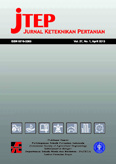Kombinasi Perlakuan Hot Water Treatment dan CaCl2 untuk Mencegah Kerusakan Fisiologis Buah Belimbing (Averrhoa carambola L.)
Abstract
Abstract
Demand and productivity of starfruit have been increased every year. With that potency, starfruit could determined as national fruit commodityto be exported. One of the obstacle that encountered by fruit export from Indonesia was the high attack of pest or fruit fly which caused many fruit do not qualify in the quarantine process. Moreover, the problem of postharvest handling should be more focused because the starfruit was perishable commodity. In this research, postharvest handling was combination of hot water treatment and soaking in CaCl2 solution. This research used starfruit variety of Dewi with ripeness index of level 4. Samples treated with hot water treatment (HWT) with three levels (35oC for 60’; 45oC for 40’ and 55oC for 15’). After HWT, samples treated with soaking in CaCl2 solution at three level treatments (60’; 40’; dan 20’). The results showed that HWT was very significantly affected on overall starfruit quality during storage, whereas treatment of soaking in CaCl2 solution wasn’t significantly affected on starfruit quality. Meanwhile, combination of HWT and CaCl2 were significantly affected to respiration rate, weight shrinkage, brightness level, yellow-blue pulp level, and panelists acceptance toward flavor and aroma. Treatment of HWT 55ºC for 15 minutes, softening of fruit pulp cannot be avoided because of the heat injury. Combination of HWT 45ºC for 40 minutes and 4% CaCl2 for 60 minutes can maintain quality till 24th day panelist acceptance test.
Keywords : starfruit, hot water treatment, CaCl2, panelist, fungi
Abstrak
Permintaan dan produksivitas buah belimbing telah menunjukkan kenaikan dari tahun ke tahun, dimana dengan potensi ini, buah belimbing bisa menjadi buah nasional andalan ekspor. Salah satu kelemahan dari buah eksport Indonesia adalah tingginya serangan penyakit dan lalat buah yang menyebabkan beberapa buah tidak bisa lolos dari proses pemeriksaan karantina. Lebih dari itu, masalah penanganan pasca panen harus lebih fokus karena buah belimbing termasuk komoditas yang mudah rusak. Pada penelitian ini, penanganan pasca panen dengan kombinasi perlakuan pecelupan air pana dan perendaman dengan larutan CaCl2. Penelitian ini menggunkan buah belimbing varietas Dewi dengan indeks kematangan 4. Sample diperlakukan dengan air panas (HWT) dengan 3 tingkat suhu dan lama perendaman (35oC selama 60’; 45oC selama 40’ dan 55oC selama 15’), Setelah HWT, sample kemudian direndam dalam larutan CaCl2 dengan 3 tingkat lama pencelupan (60’; 40’; dan 20’). Hasil penelitian menunjukkan bahwa perlakuan HWT sangat berpengaruh pada seluruh parameter mutu buah selama penyimpanan, namun perlakuan pencelupan dengan larutan CaCl2 tidak berpengaruh pada mutu produk. Kombinasi perluan keduanya berpengaruh terhadap parameter kecepatan respirasi, susut bobot, tingkat kecerahan kulit, level warna kuning-biru daging buah, serta tingkat penerimaan panelis terhadap bau dan aroma. Pada perlakuan HWT dengan suhu 55ºC selama 15 menit,menyebabkan pelunakan daging buah akibat dari ‘heat injury’. Kombinasi perlakuan HWT 45ºC selama 40 menit dan 4% CaCl2 selama 60 menitsdapat mempertahankan mutu buah sampai hari ke-24 berdasarkan penerimaan panelis.
Kata kunci :buah belimbing, hot water treatment, larutan CaCl2, heat injury, perishable
Diterima:4 Desember 2012; Disetujui:28 Maret 2013
Authors
Authors submitting manuscripts should understand and agree that copyright of manuscripts of the article shall be assigned/transferred to Jurnal Keteknikan Pertanian. This work is licensed under a Creative Commons Attribution-ShareAlike 4.0 International License (CC BY-SA) where Authors and Readers can copy and redistribute the material in any medium or format, as well as remix, transform, and build upon the material for any purpose, but they must give appropriate credit (cite to the article or content), provide a link to the license, and indicate if changes were made. If you remix, transform, or build upon the material, you must distribute your contributions under the same license as the original.

